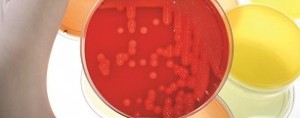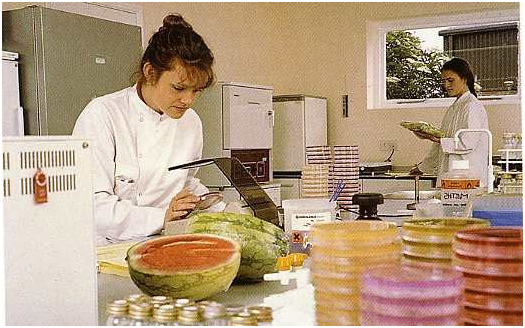Indicator organisms are microorganisms that signify the possible contamination of food or food products as well as other materials or environment. They are organisms whose presence in a material or environment serves to indicate the condition or quality of the material or environment. To meet the local and internationally established microbiological criteria for safe and quality food and food products; it is critical to determine the microbiological quality of food and food products as a way of knowing their shelf life and health benefits to the consumers preferably humans and animals.
Indicator organisms show the degree of contamination or pollution of a particular environment (e.g. water and food) especially after carrying out microbiological analysis (e.g. viable count or total count) on representative samples of the environment. Microorganisms in this category indicate the pollution of water or foods; and they are usually of feacal origin. Bacteria that are known to be indicator organisms are usually members of the Enterobacteriaceae family; and Escherichia coli, Streptococci, Enterococcus species, Salmonella and coliform bacteria are the most common indicator organisms of food contamination.
Microorganisms that are indicator organisms indicate the standard of hygiene of food during preparation or processing. Since most food processing techniques apply heat in their processes, it is expected that food indicator organisms will be killed during the heating process that characterized the majority of food processing techniques. However, when indicator organisms are found in processed food or food products, it is an indication of poor food handling or processing since some of the food processing techniques are expected to kill the food indicator microorganisms.
Indicator organisms usually emanate from the feaces of humans and animals; and when these human or animal wastes come in contact with food or raw materials for food processing, they easily contaminate the food and this can cause several health anomalies in consumers. And due to the feacal origin of these organisms especially E. coli, their presence in food or food products easily indicate the feacal contamination of the food either form humans or animal feaces. E. coli is a lactose-fermenting Gram negative bacterium in the family Enterobacteriaceae; and it is found as normal flora in the gastrointestinal tract (GIT) of animals and humans.
Their presence in food or food products implies or shows some history of microbial contamination of feacal origin. This bacterium (an important indicator organism of food and water contamination) can also be found in the soil and water as well as in food due to possible feacal contamination as a result of indiscriminate defecation in the open or in water ways by humans and animals.
Various pathogenic strains of E. coli including enteropathogenic E. coli (EPEC), enterotoxigenic E. coli (ETEC) and enteroinvasive E. coli (EIEC) amongst others are mainly responsible for the disease outcomes of E. coli invasion of the human body. Indicator organisms are common intestinal bacteria of animals and humans as aforementioned; and their presence in a particular environment (e.g. food or water) apart from showing feacal contamination of the environment could also indicate poor treatment or processing of the material under investigation.
These organisms can also indicate the sewage contamination of the environment; and their presence in processed food or food products can also signify inadequate food processing. Most probable number (MPN) test, membrane filtration technique, sample culture on selective growth media, coliform test, total count and viable counts are some examples of microbiological tests that can be used to test for the presence of indicator organisms in a particular environment including food and water.
Currently, rapid detection techniques such as the use of chromogenic compounds in culture media, immunological/serological techniques (using monoclonal antibodies), and gene-sequencing based techniques such as PCR and fluorescence in situ hybridization (FISH) methods are available for the rapid detection of indicator organisms from feacally-contaminated materials. In any of these tests, the sample is serially diluted; and aliquots of the diluted sample to be investigated for the presence of indicator organisms is inoculated in broth culture media and solid culture media including MacConkey broth, MacConkey agar, salmonella-shigella agar and plate count agar.
The inoculated culture media are incubated in the incubator at 37oC for 18-24 hrs; and resultant colonies on the solid culture media plates are subcultured and tested biochemically using tests like indole test for the presumptive identification of the indicator bacteria present in the sample. In some microbiological tests for determining the presence of indicator organisms in samples, the Durham tube test method (which shows gas production by the organism) and the most probable number (MPN) method are usually employed.
However, the type of test to be used when investigating the presence of indicator organisms in a particular environment is dependent on several factors including the type of sample to be investigated (liquid or solid), the source of the sample, and the probable indicator organisms being sought for. Generally, the methods for the microbiological examination of food samples especially for the presence of indicator organisms and other food borne pathogens include cultural techniques, direct examination using microscopy, immunological or serological procedures, and molecular techniques based on the use of PCR as aforementioned.
To be effective as an indicator organism, the microorganisms used as indicator organisms in determining the microbial quality of a given product or environment must meet certain criteria before they can be qualified to be used to determine the feacal contamination of the environment. According to the United States of America Environmental Protection Agency (EPA), indicator organisms must meet these criteria in order to be considered an ideal indicator of feacal contamination of the environment including water and food. It is vital that these criteria as shall be explained here are met and considered when evaluating the fecal contamination of a particular environment in order to get optimum result. Some of the major attributes of a microorganism that make it an ideal indicator are as follows:
- The organism should be found as a normal microflora in the intestinal tract of warm-blooded animals including humans.
- The organism must be sensitive to the substance being analyzed.
- The organism should be present whenever enteric pathogens are present.
- The organism should not grow in the environment to be analyzed.
- The organism should have a longer survival time than the hardest enteric pathogen.
- It must be easily activated upon examination.
- The organism must have some metabolic functions or response that is measurable.
- The organism should be useful for all types of environment including food and water.
- The organism must not be susceptible to variations in sensitivity.
- The organism should be specific if possible.
- The organism should not be naturally pathogenic.
References
Bushell M.E (1998). Application of the principles of industrial microbiology to biotechnology (ed. Wiseman, A.) Chapman and Hall, New York.
Byong H. Lee (2015). Fundamentals of Food Biotechnology. Second edition. Wiley-Blackwell, New Jersey, United States.
Clark D.P and Pazdernik N (2010). Biotechnology. First edition. Elsevier Science and Technology Books, Amsterdam, Netherlands.
Farida A.A (2012). Dairy Microbiology. First edition. Random Publications. New Delhi, India.
Frazier W.C, Westhoff D.C and Vanitha N.M (2014). Food Microbiology. Fifth edition. McGraw-Hill Education (India) Private Limited, New Delhi, India.
Guidebook for the preparation of HACCP plans (1999). Washington, DC, United States Department of Agriculture Food Safety and Inspection Service. Accessed on 20th February, 2015 from: http://www.fsis.usda.gov
Hayes P.R, Forsythe S.J (1999). Food Hygiene, Microbiology and HACCP. 3rd edition. Elsevier Science, London.
Hussaini Anthony Makun (2013). Mycotoxin and food safety in developing countries. InTech Publishers, Rijeka, Croatia. Pp. 77-100.
Jay J.M (2005). Modern Food Microbiology. Fourth edition. Chapman and Hall Inc, New York, USA.
Lightfoot N.F and Maier E.A (1998). Microbiological Analysis of Food and Water. Guidelines for Quality Assurance. Elsevier, Amsterdam.
Nduka Okafor (2007). Modern industrial microbiology and biotechnology. First edition. Science Publishers, New Hampshire, USA.
Roberts D and Greenwood M (2003). Practical Food Microbiology. Third edition. Blackwell publishing Inc, USA.
Discover more from #1 Microbiology Resource Hub
Subscribe to get the latest posts to your email.



